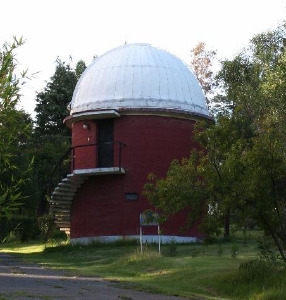
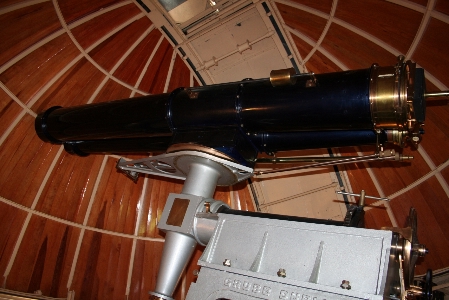


The major Mexican observatory for several decades was located in Tonantzintla, outside Puebla (and slightly protected from the lights of Mexico City by the volcanic bulk of Popocatepetl and Iztaccihuatl). Its 1942 inauguration is familiar to philatelists through the series of stamps issued in its honor, featuring photographs of galaxies and nebulae. This series is rare and much prized among collectors. The smallest telescope on the site was the Carte du Ciel astrograph (shown above), relocated in 1951 from its earlier site at Tacubaya. This double astrograph was part of a global collaboration to map the sky astrometrically, organized by French observatories in 1887. In hindsight, this was not the best use of resources... The telescopes were nominally identical at each site. The Tacubaya astrograph is representative, with an equally large guide telescope and a cross-axis equatorial mount.
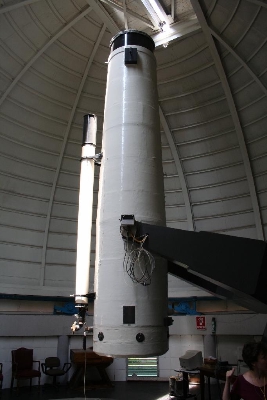
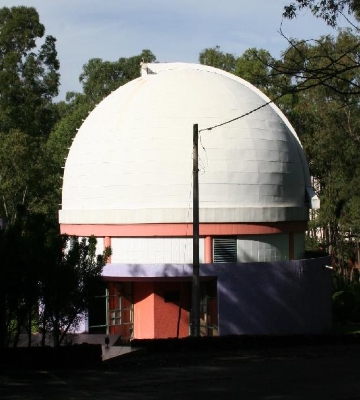
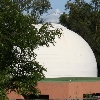 Much
of Tonantzintla's astronomical reputation was made with its
64-cm Schmidt telescope, above all as used by Guillermo Haro.
For direct photography or in conjunction with an objective prism,
it saw important use in surveys for flare stars, Hα
emission stars, and a survey of the entire galactic plane for
hot stars. This last project was only possible from a single site
if at very low latitude rendering the entire galactic plane observable.
Did I mention discovery of Herbig-Haro objects? The guide scope
is mounted on two rings widely separated on the main tube, not
only for stability but to that it will follow flexure of the main
telescope to first order. Adding to the special visual qualities of
this site, if you stand in the right pace up the hill, you can see
the summit of Popocatepetl steaming directly above the dome.
Much
of Tonantzintla's astronomical reputation was made with its
64-cm Schmidt telescope, above all as used by Guillermo Haro.
For direct photography or in conjunction with an objective prism,
it saw important use in surveys for flare stars, Hα
emission stars, and a survey of the entire galactic plane for
hot stars. This last project was only possible from a single site
if at very low latitude rendering the entire galactic plane observable.
Did I mention discovery of Herbig-Haro objects? The guide scope
is mounted on two rings widely separated on the main tube, not
only for stability but to that it will follow flexure of the main
telescope to first order. Adding to the special visual qualities of
this site, if you stand in the right pace up the hill, you can see
the summit of Popocatepetl steaming directly above the dome.
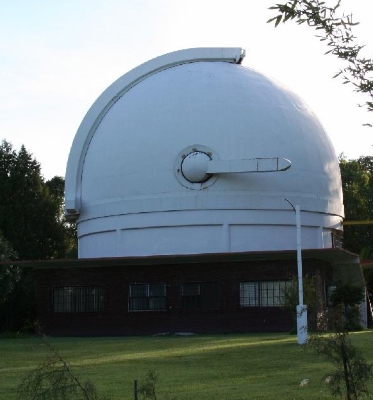
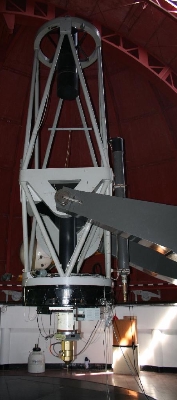
The growing light pollution from the metropolis of Puebla, and desire for more favorable astronomical climate, led to the search for a better Mexican site. In 1966, they identified San Pedro Martir in Baja California as a high-quality site, where major new Mexican facilities have been developed since then. The last new telescope at Tonantzintla has been a 1-meter instrument in operation since 1997, by the Universidad Nacional Autonoma de Mexico. This instrument can be operated remotely from Mexico City by students and staff, a real boon when one considers the traffic delays often encountered on the way out of the city. The unusual boom on the outside of the dome functions as a counterweight for an internal crane. This side view of the fork mount shows quite clearly the low latitude of Tonantzintla (about +19 °).
Last changes: 04/2007 © 2007